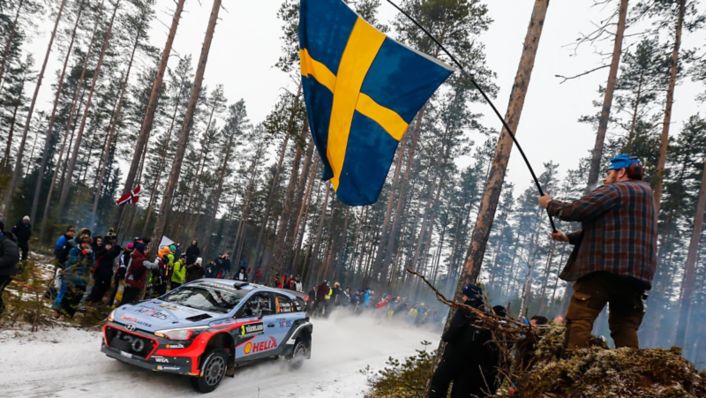When Hyundai Motorsport’s i20 tackles gravel, sand, or snow tracks during the World Rally Championship season, the team knows the importance of tyre pressure and performance to survive and thrive on different terrains and weather conditions around the world.
A high-performance vehicle in the high-octane world of motorsports is a feat of engineering, combining elements such as design, engine performance, and aerodynamics. And another key component is the tyre.
Equally, the SUV owner who negotiates busy urban streets, or heads off-road in the rain-sodden countryside relies on the car’s tyres for grip, stability, and above all, safety.
The invention of the wheel is cited as one of mankind’s greatest feats but the tyre has undergone many reinventions over its lifetime. Early tyres were bands of leather or metals like iron and steel placed on the wooden wheels of wagons and carts. Nowadays, modern air-filled - or pneumatic - pressure tyres are a mix of synthetic rubbers and wires.
The earliest rubber tyres didn’t use air. They were solid rubber and because they had poor shock absorption were mainly used on vehicles with slower speed. Pure rubber wasn’t the most useful substance. It became sticky in hot weather and inflexible in the cold. Charles Goodyear is credited with discovering the process of vulcanization in the 1830s. By heating rubber with sulphur, the sticky rubber became firmer and therefore pliable.
A high-performance vehicle in the high-octane world of motorsports is a feat of engineering, combining elements such as design, engine performance, and aerodynamics. And another key component is the tyre.
Equally, the SUV owner who negotiates busy urban streets, or heads off-road in the rain-sodden countryside relies on the car’s tyres for grip, stability, and above all, safety.
The earliest tyres were bands of leather or metal
The invention of the wheel is cited as one of mankind’s greatest feats but the tyre has undergone many reinventions over its lifetime. Early tyres were bands of leather or metals like iron and steel placed on the wooden wheels of wagons and carts. Nowadays, modern air-filled - or pneumatic - pressure tyres are a mix of synthetic rubbers and wires.
The earliest rubber tyres didn’t use air. They were solid rubber and because they had poor shock absorption were mainly used on vehicles with slower speed. Pure rubber wasn’t the most useful substance. It became sticky in hot weather and inflexible in the cold. Charles Goodyear is credited with discovering the process of vulcanization in the 1830s. By heating rubber with sulphur, the sticky rubber became firmer and therefore pliable.
Tyre technology has come a long way since metal bands were bolted to wooden wheels. Nowadays, they are a vital component of high-performance sports cars and your family SUV alike.

The first pneumatic tyre
The pneumatic car tyre encloses pressured air in rubber to improve traction and reduce vibration. The first patent for a standard pneumatic tyre was made in 1847 by the Scottish inventor Robert William Thomson but never went into production. In 1888 in Belfast, John Boyd Dunlop, became the second inventor of a pneumatic tyre, designed to help his young son while riding his tricycle on rough surfaces.
At that time, manufacturers depended on natural rubber but the 1920s saw the development of synthetic rubber.Different methods of construction became common through the 20th Century. The tyres were made up of an inner tube, and the outer casing, designed for traction, was reinforced with rubber layers called plies, made up of cords embedded in the rubber.
The orientation or angle of these plies changed over time. For example, antique equipment like tractors and collector cars often used what were called bias ply tyres. These eventually gave way to radial tyres, developed in the USA in the 1940s but quickly exported to Europe and Asia. These tyres had the advantages of longer tread life, improved steering, fewer punctures, and lower resistance.
Computer system to monitor tyre pressure
Different vehicles require different types of tyres, depending on their use and industry. And for the everyday European driver, different car tyres suit varying road surfaces and weather conditions throughout the continent, especially in winter. Some countries, such as Germany, require that cars are equipped with winter tyres (designed for improved grip in snow and ice conditions) by law.
Today's car technology allows drivers to monitor the condition of their tyres even while sat behind the wheel. Models like the Hyundai Tucson include a Tire Pressure Monitoring System (TPMS) to provide a warning on the dashboard if any of the car’s four tyres are low on pressure.
Likewise, in the competitive world of WRC, tyres play a huge part in Hyundai Motorsport’s pursuit of success. For example, Rally Sweden is renowned for its snowy terrain and icy temperatures. Special studded Michelin tyres were fitted to the Hyundai i20 Coupe WRC, which also meant the car’s overall set-up had to be tweaked to get the best possible results.
It's a far cry from the humble wooden wheel but car tyre technology continues to revolve, and evolve.
Tucson
Consumption Data*
Gasoline Engines
1.6 GDi (132 PS): Fuel consumption combined: 6.3 l/100 km; urban: 7.9 l/100 km; extra-urban: 5.4 l/100 km; CO2 emissions combined: 147 g/km
1.6 GDi (177 PS): Fuel consumption combined: 7.6 - 7.1 l/100 km; urban: 10.0 - 9.0 l/100 km; extra-urban: 6.5 - 5.8 l/100 km; CO2 emissions combined: 177 - 165 g/km
Diesel Engines
1.7 CRDi (116 PS): Fuel consumption combined: 4.6 l/100 km; urban: 5.4 l/100 km; extra-urban: 4.1 l/100 km; CO2 emissions combined: 119 g/km
1.7 CRDi (141 PS): Fuel consumption combined: 4.9 l/100 km; urban: 5.4 l/100 km; extra-urban: 4.7 l/100 km; CO2 emissions combined: 129 g/km
2.0 CRDi (136 PS): Fuel consumption combined: 6.0 - 4.8 l/100 km; urban: 7.0 - 5.6 l/100 km; extra-urban: 5.3 - 4.4 l/100 km; CO2 emissions combined: 156 - 127 g/km
2.0 CRDi (185 PS): Fuel consumption combined: 6.5 - 5.9 l/100 km; urban: 8.0 - 7.1 l/100 km; extra-urban: 5.6 - 5.2 l/100 km; CO2 emissions combined: 170 - 154 g/km
*Depending on trim and tire specifications.











